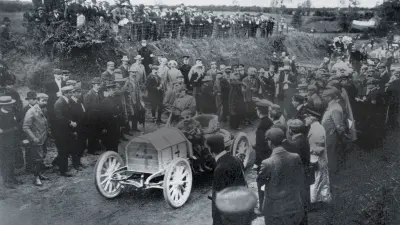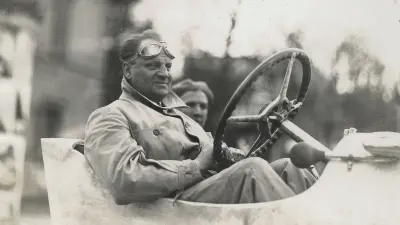Camille Jenatzy – racing driver, “red devil”, and advertising motif for Bosch

Camille Jenatzy was one of the most successful racing drivers in the world in the first decade of the 20th century.
The Belgian, a wealthy tire manufacturer and dealer, was a legend in his own lifetime thanks to his risky driving style and flamboyant appearance, with pointed beard, flowing dust coat, and goggles pushed up on his forehead.
The event that earned him his fame more than any other was the 1903 Gordon Bennett Cup race. Named after its organizer, a millionaire American publisher, the Cup was staged for the first time in 1903 in Ireland. Although it was initially to have been held in England, the strict traffic laws there were incompatible with a country-wide motor racing event – the speed limit of 10 miles an hour for automobiles being less than ideal.
Winning despite limited horsepower

Blessing in disguise
Jenatzy won the race, as he did many others thereafter, but the 1903 Cup was special. Jenatzy’s 90 hp Mercedes had been destroyed in a fire, which meant he had to drive a different Mercedes that a rich motorist had made available for the race at the last minute. However, the new machine was only 60 hp – around 30 percent less powerful that his rivals’ vehicles – and yet Jenatzy won the race.
Bosch was interested in Camille Jenatzy because his (winning) Mercedes automobiles always used Bosch ignition systems. In the days before vehicles were put through detailed tests, what could serve as better advertising than an ignition system proving itself under the harshest of conditions?
Jenatzy becomes the “red devil”
Bosch took the decision to have a stylized version of Jenatzy – as a “red devil” – represent it as an advertising motif designed to promote the Bosch magneto ignition system or Bosch spark plugs. The first advertisements using this motif can be traced back to 1909 and the draft for the first poster featuring the “red devil” probably dates from 1910.
It is highly likely that the motif was designed by advertising artist Julius Klinger, who was working at Stuttgart-based agency “Propaganda” at the time.
Why was he called a “red devil”? The answer is simple. Jenatzy had red hair and a red beard and the coat he wore to protect himself from the dust that was kicked up from the poor quality roads of the time was also red. Unfortunately, all that is lost in the historic black and white footage that still exists. It was these colors that inspired Klinger, as an artist, to make red the dominant hue for the motif.
Corporate Design
The image was used all around the world on advertisements and posters – even impressive, larger-than-life, three-dimensional devils were put on show at trade fairs. The “red devil” became a logo and is the earliest example of “corporate design” at Bosch. The devil would always be holding a Bosch product in his hands, most often a magneto ignition system, or a display board printed with promotional text or information from Bosch. The most widely used poster features a giant-sized red devil holding a Bosch magneto ignition system in his hands that is connected by cables to multiple racing cars.
The radiator of the car in the lead usually displayed the national emblem or flag of the country where the poster was on display. It was an obvious nod to the patriotism of local customers.
Later on, the red devil was also used to advertise spark plugs, an indispensable accessory for magneto ignition and subsequent systems.

After the “red devil”
At the end of the First World War, the glory days of the motif were behind it. The authorities in the U.S. had confiscated the production locations and branches that Bosch had in the country — along with the logo.
Now that Bosch was not permitted to use the “red devil” logo and naturally also wanted to distinguish itself from the newly American-owned “American Bosch Corporation”, the “red devil” ceased to be a logo and trademark for Bosch on advertisements and posters.
Instead, it was the “bursting spark” of the spark plug, a design from artist Lucian Bernhard dating to around 1914, that became the main advertising motif.
The new logo for the company was the armature in a circle, the stylized double-T armature of the magneto ignition system.
This design was conceived in 1918 by Gottlob Honold, the head of engineering at Bosch at the time. The double-T armature was rolled out as the logo for Bosch in Germany in 1919 and worldwide in 1920 —and is still in use today.
Author: Dietrich Kuhlgatz
